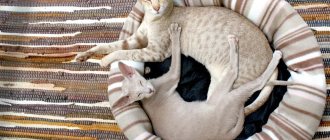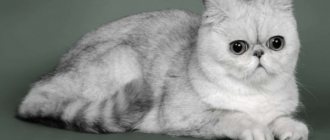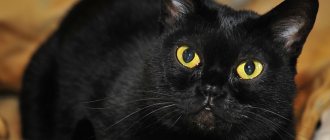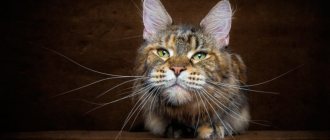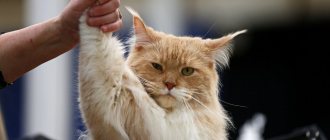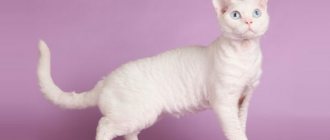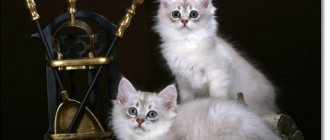Origin story
This energetic and stunningly charismatic representative of the cat family looks like a tiger.
Actually, this was what Judy Sugden was guided by when creating a new breed for lovers of wild predators. The work lasted from the end of 1980 until 2007, and included many cats (both outbred and purebred: Bengals). The TICA organization included toygers on its lists back in 1993, but cats were able to participate in exhibition events only 14 years later.
Toygers are not cheap: the price tag for a striped baby starts from 50,000 rubles and can reach 100,000-120,000 rubles (for breeding - 200,000). Such a high price is due to the fact that there are no nurseries in Russia where this breed would be bred, and animals have to be ordered from England through intermediaries.
Briefly about the breed
The name of the cat breed “toyger” literally translates as “toy tiger”. American biologist-geneticist Judy Sugden bred a miniature copy of the tiger in the 90s, and since 2007 the toyger has been officially recognized by all international associations.
Cats are large animals and weigh on average about 10 kg. Distinctive signs of thoroughbred are the rounded contours of the head and muzzle in the shape of an inverted heart, tilted eyes, smooth movements and a strong, muscular, springy body.
Standard
The breeder spent a long time putting together the “puzzle” of the breed, trying to get a cat that was beautiful and strong, with the appearance of a tiger, but without giving the impression of being a clumsy and overly massive creature. Toygers have a wide bone, muscular build and a stretched body.
| Standard | Description |
| Head | Small in size, slightly elongated to the sides, with a rounded chin and plump whisker pads. |
| Eyes | Medium size, deep set, with yellow-green iris. |
| Nose | Quite long, with a large lobe. |
| Ears | Small, set wide apart, with rounded tips. The auricle is abundantly pubescent both inside and outside. |
| Torso | Massive, with a wide chest and medium-length limbs. |
| Paws | Elongated, elastic. |
| Tail | Long, thick, with a rounded tip. |
| Wool | The fur is short, elastic and dense. There are so-called fringes in the chin area and temples. |
The toyger is large in size, and the weight of females is 3.5-5 kg and the weight of males is 5-7.5 kg.
Disadvantages of the breed:
- A different shade of fur.
- Blue eyes.
- Malocclusion.
- A different shade for the tip of the tail.
Choose an active kitten with a good appetite. Weakness, lethargy, and cowardice can indicate both a weak character and some kind of disease.
Color
According to the standard, the basic coat color cannot be uniform. Light areas in the chest, paws and abdomen are required. The most common color is brindle (its second name is mackerel): a golden background with a red tint and vertical stripes of brown color. The undercoat may be greyish. There are light “spectacles” around the eyes, and a light spot on the ears (similar to a fingerprint. There are black dots on the whisker pads, and a black rim around the eyes and lips.
In the photo there is a Toyger cat of the correct color
Owners often offer silver toygers for sale: with a light background and brown stripes. These individuals have very soft and delicate fur, but they do not yet fall under the general standard.
Character and behavior
Toyger is a walking curiosity. There won't be a corner in your house that he won't poke his little nose into. And this, unfortunately, does not always look funny: a pan of boiling water, an electrical outlet, or an open balcony pose a real danger. With the appearance of a striped baby, you will have to forget the old habit of leaving pills and wires anywhere, otherwise the kitten will try to taste both.
He is playful, but will not run around the house like a fury and knock everything off the shelves. He is absolutely not vindictive and will easily forgive you for trampling his tail, for stuffing him with deworming pills, and for carrying him around in a carrier. Trusting and sociable: he quickly goes into the arms of guests. Excellently trainable and easily learns new commands.
Children are the best friends for a Toyger. It is unthinkable for a cat to offend a baby, so they obediently endure all the games and tail-pulling. They love to sleep with children in the same bed.
The toyger knows how to get along not only with representatives of the human race, but also with other animals. And not only their own kind, but also dogs, small rodents and similar living creatures. These individuals have no hunting instinct, which means: your favorite hedgehog can calmly stomp around at night, without fear of getting into the teeth of a zealous hunter. The toyger will not be jealous when he sees that you are paying attention to another pet, and even more so, he will not take revenge.
Reviews
Alina:
“I didn’t intend to get a cat, but after seeing this miracle on the Internet, my opinion changed. I really wanted her. It was difficult to get. We contacted the cattery, but we had to wait 3 months for a kitten. When I saw him, it was love at first sight. The sweetest creature, with big, kind eyes. The stripes really look great. As the cat grew, it became even funnier; playfulness does not disappear with age. But it becomes majestic and graceful. In general, the behavior resembles that of a tiger. We have 2 sons in our family. They torment the cat as best they can. One is 4, the other is 5 years old. Our tiger doesn’t complain about anything, he follows on their heels to play. Even my husband did not remain indifferent to him, although he had not liked cats before. In general, such a creation will enliven any home and absolutely everyone will like it.”
Olga:
“They gave me a cat, brought from England. I had never heard of the breed before, but I was told that the cat is fashionable. I immediately liked him for his funny behavior and gentle temperament. It does not scratch at all, as if there were no claws. He doesn't do any mischief. He doesn’t climb on tables, he quickly learned where the potty was, there were no problems with it. He eats everything I give. Of course, I read beforehand what he could and couldn’t do. He loves cottage cheese very much. I buy rustic, no chemicals. We take care of the cat. We rarely give dry food, but it happens. Already 6 months old, becoming more and more beautiful with age. During this time I haven’t been sick with anything, I let him go outside under supervision, and I don’t let him near other cats.”
Video
Care instructions
Wool
The Toyger's short coat does not require special manipulation. It does not roll into tangles, and molting occurs only once a year and is almost imperceptible. To care for it, you just need to buy a rubber brush.
Bathing
Toygers are indifferent to bathing: they are unlikely to get into the water themselves, but they will not be particularly indignant about bathing procedures. Buy a mild cat shampoo that does not contain coloring ingredients, and bathe the animal once every six months or when dirty.
Does your cat like to swim?
Not really
Ears
The ears are examined once a month, and dirt is removed with a damp swab.
Teeth
You will also have to brush your teeth at least once a week, using a soft toothbrush (you can use a children's brush) and cat toothpaste.
Claws
It is not necessary to cut their claws: toygers quickly learn to grind them off on scratching posts.
Interesting Facts
The name Toyger cats comes from a combination of two English words: “toy” (toy) and “tiger” (tiger).
The pattern on the fur of toygers is never repeated. It is as unique as a person's fingerprint.
Toygers are among the TOP most expensive cats in the world. The minimum cost of a kitten not intended for selection is 60,000 rubles. The price for elite manufacturers reaches 300,0000 rubles.
There is a hypothesis that during the selection process these animals lost their “sense of the trail.” If they get lost, they will not be able to find their way home on their own.
Catering
A balanced and high-quality diet is a must if you want to raise your pet healthy and strong.
But food from your own plate is not suitable: fried, smoked, sweet foods are death for a cat's stomach. You will have to follow a number of rules. Don't be afraid: there is nothing complicated about them.
Natural products
When choosing natural food, follow the recommendations of the breeder and veterinarians. Both of them strongly recommend not feeding the animal salty and sweet dishes, pickled foods, baked goods, citrus fruits, and sweets (chocolate is strictly prohibited).
List of permitted products:
- lean meats: beef, veal, rabbit, turkey, rabbit;
- fish: flounder, hake, salmon, trout, cod;
- dairy and fermented milk products: low-fat cottage cheese, sour cream, yogurt, cream, natural yogurt;
- vegetables: zucchini, pumpkin, carrots, broccoli, asparagus, green salad;
- cereals: buckwheat, rice, millet, oatmeal, pearl barley;
- purified drinking water (temperature comfortable for the animal).
The presence of dyes, GMOs, artificial and chemical components in food is not allowed.
Recommended food
You can also feed your cat commercial food. Modern food is affordable and formulated taking into account all the basic needs of the animal.
Experienced breeders advise buying food from holistic groups: Primordial, Pronature Holistic, Savarra. Super premium: Naturea, Vigor & Sage, Vet Life. The rest (premium and economy class) have a poor composition and too many questionable components in the composition (for example, artificial preservatives, flavor enhancers, etc.).
Below are recommended super-premium foods. Links with the names of the food are clickable, on them you can, within our website, get acquainted with the descriptions of the food and read reviews from owners of Toyger cats.
| Holistic | Super premium | Super premium |
| Riverwood | Optima Nova | Monge |
Diseases
No genetic diseases have been identified in this breed, and no serious diseases have been reported either. The most your pet can suffer from is a common cold. Therefore, make sure that the animal does not lie in a draft and does not freeze after bathing.
Vaccinations are required if you love your pet and want him to be healthy. Even if you do not let your cat go for walks, pathogens can easily be brought home on your own hands (if you stroke the animal with unwashed hands), but on the soles of shoes or street clothes.
Rabies, rhinotracheitis, panleukopenia, calcivirosis are deadly diseases from which the animal must be protected. Currently, there are a number of complex vaccines (which contain not one, but several components), which are administered from an early age (6-10 weeks). Repeated vaccinations are given once a year. Popular vaccines on the domestic market: Nobivak (Tricket and Forcat), Quadrikat, Leukorifelin, Multifel-4, Fel-O-vax), Primucel.
Expert opinion
Dusheba Vera Ivanovna
In 2010, she graduated from the Moscow State Academy of Veterinary Medicine named after K.I. Scriabin with honors, specializing in veterinary medicine. I regularly attend veterinary conferences, congresses, and webinars.
Before vaccination, be sure to give your cat anthelmintic medications. But not human ones - they will cause poisoning! - and special ones, for animals. Before purchasing the drug, be sure to consult your doctor. It is impossible to drive worms from pregnant cats (in the first half of the term), in the presence of infectious diseases, pathologies of the urinary system and liver, as well as in kittens under 6 weeks of age.
Photo gallery
Below are photos of Toyger cats.
Approximate prices for tiger kittens
Tiger kittens are sold in nurseries. Prices depend on the breed.
| Breed | Price, rub.) |
| Toyger | 60,000. For breeding they cost 200,000 rubles, as they are imported from foreign nurseries |
| Oncilla | 140000 |
| Bengal cat | 70000 |
| Tabby | 70000 |
| Sokoke | 60000 |
| Savannah | 500000 |
| Egyptian Mau | 100000 |
| Asherah | 4000000 |

